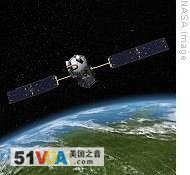Washington
30 January 2009
Next month, the U.S. space agency NASA will launch the first satellite designed exclusively to answer questions about the distribution and source of carbon dioxide in the atmosphere, which is largely responsible for global warming.
Scientists say at least 95 percent of carbon dioxide in Earth's atmosphere comes from natural sources, such as animal and plant respiration.
They believe global warming is caused by the remainder of carbon dioxide from manmade sources, such as tailpipe emissions and deforestation, trapped in the atmosphere.
 |
| Artist's concept of Orbiting Carbon Observatory |
"OCO's unique use of mature technology will enable NASA's first space-based measurements of carbon dioxide with the accuracy and coverage needed to understand how carbon dioxide affects the climate and how in turn the global carbon cycle is affected by changes in the climate," explained Eric Ianson, OCO's program director.
The OCO will cover the Earth the every 16 days, using spectrographs to detect sources of CO2 and methane, another greenhouse gas.
Scientists say humans emit eight billion tons of carbon into the atmosphere through fossil fuels and land use, but only half of that remains in the atmosphere.
The rest of the greenhouse gases are absorbed back into the Earth into what scientists call carbon sinks.
So, a key part of the $278 million-mission will be devoted to understanding the carbon cycle of which sinks are a part, according to mission scientist Anna Michalak.
"And so as carbon cycle scientists what we want to understand is exactly why and how and where these sinks of carbon from the atmosphere to the oceans and plants are taking place because that will then affect concentrations of carbon dioxide in the atmosphere and that in turn affects climate change," Michalak said.
Meanwhile, Japan last week launched the first satellite to monitor greenhouse gases worldwide.
Known as GOSAT, officials say the orbiter, combined with data collected by NASA's OCO exploration satellite, will offer a treasure trove of information on global warming that cannot be gathered by ground based stations.